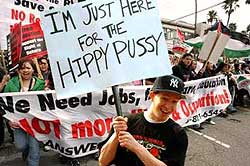Meanwhile, the San Joaquin Valley gets paved over, and people commute from there to San Jose and back daily in 100 mile round trips!
Personally, if it were up to me, I’d fill in ALL the precious wetlands (i.e., swamps) around the Bay Area and let a hundred Foster Cities bloom.
Oh, but that would destroy the precious ecosystem? Relative to what? Paving over acre after acre of San Joaquin Valley farm and rangeland (with countless critters displaced)? And forcing people into 100 mile round trip commutes (with countless tons of extra fuel burned and extra smog produced)?
In the San Jose and the Greater Bay Area, there has been, in effect, a concerted effort NOT to house people anywhere near where they work, at least not affordably. The ability to build new housing is the most difficult in the localities of Northern Cali that need it most.
Runaway environmentalism, starting with an "every swamp is sacred" movement in the 1960’s, compounded by an "every hill is sacred" movement in the 1980’s, reduced the available land for building, which drove up prices. Given that for local planners, housing development always comes in third behind more tax revenue lucrative industrial and commercial development, this really hit hard.
Moreover, the housing built had to be built with so many mitigating factors that the housing built was only affordable to the upper income or the already wealthy. Adding to this was good old fashioned NIMBYism, where those who already had homes didn’t want more construction disrupting what a nice arrangement they already had.
One of the unintended consequences of bay area growth control, besides pushing people out to the Sacramento and San Joaquin Valley, is that it changes the dynamics of the homebuilding industry to the detriment of home buyers. In addition to boosting home prices overall, the home building industry tends to respond to growth constraints by building different types of housing than would otherwise be built in the absence of controls. When fewer homes are allowed to be built, builders typically build larger, more expensive homes to preserve their operating margins. This results in even fewer homes that are affordable to low and middle income households.
The growth controls also reduced the number of homebuilders in the Bay Area. The local homebuilding industry went from a competitive market offering the consumers the benefit of numerous producers, to a cartel-like market where a few large building companies now dominate the market. This happened because greater regulatory risk made it harder for smaller developers to compete in the area. The regulation risk serves as a barrier to entry, ultimately leading to a monopoly situation where only a few large developers are able to compete in a given market.
Some developers went further out where they were more welcome, and merrily built their subdivisions. And people drove farther and farther to their jobs, unless their jobs moved out to meet them, which in some cases has happened.
As a result, what was once arguably just a four-county "Greater San Francisco" area, quickly became a nine-county "Bay Area", and is now on its way to being a 14-county "Bay Area", in effect.
For now, there are thousands coming from Tracy (and soon even further, as Tracy reacts with its own growth controls), clogging up Interstates 205 and 580 into the Bay Area. People are driving longer and farther, burning up more gasoline and wasting more time, ironically, all in the name of "protecting the environment" and "quality of life".
Thank you, eco-fiends.
Thursday, March 08, 2007
Subscribe to:
Post Comments (Atom)











No comments:
Post a Comment